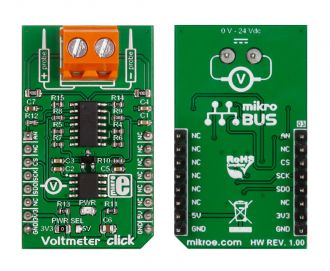
We strongly encourage users to use Package manager for sharing their code on Libstock website, because it boosts your efficiency and leaves the end user with no room for error. [more info]

Rating:
Author: MIKROE
Last Updated: 2019-04-04
Package Version: 1.0.0.1
mikroSDK Library: 1.0.0.0
Category: Measurements
Downloaded: 6532 times
Not followed.
License: MIT license
Voltmeter click is a mikroBUS add-on board for measuring voltage in an external electric circuit. The board is designed to measure Direct Current only, and has a measurement range is from 0 to 24V (it’s possible to measure both positive and negative charges).
Do you want to subscribe in order to receive notifications regarding "Voltmeter click" changes.
Do you want to unsubscribe in order to stop receiving notifications regarding "Voltmeter click" changes.
Do you want to report abuse regarding "Voltmeter click".

Library Description
The library covers all the necessary functions to control the Voltmeter click board. Voltmeter click communicates with the device via SPI driver by reading from registers. This library contains drivers for generic read ADC value, for calibrating and for voltage reading function.
Key functions:
Examples description
The application is composed of three sections:
void applicationTask()
{
adcValue = voltmeter_readData();
WordToStr( adcValue, logText );
ltrim( logText );
mikrobus_logWrite( " ADC Value: ", _LOG_TEXT );
mikrobus_logWrite( logText, _LOG_LINE );
voltage = voltmeter_getVoltage( _VOLTMETER_VCC_5V_COEFF_2 );
FloatToStr( voltage, logText );
ltrim( logText );
mikrobus_logWrite( " Voltage : ", _LOG_TEXT );
mikrobus_logWrite( logText, _LOG_TEXT );
mikrobus_logWrite( " mV ", _LOG_LINE );
mikrobus_logWrite( "------------------------", _LOG_LINE );
Delay_1sec();
}
Other mikroE Libraries used in the example:
SPIUART​ConversionAdditional notes and informations
Depending on the development board you are using, you may need USB UART click, USB UART 2 click or RS232 click to connect to your PC, for development systems with no UART to USB interface available on the board. The terminal available in all MikroElektronika compilers, or any other terminal application of your choice, can be used to read the message